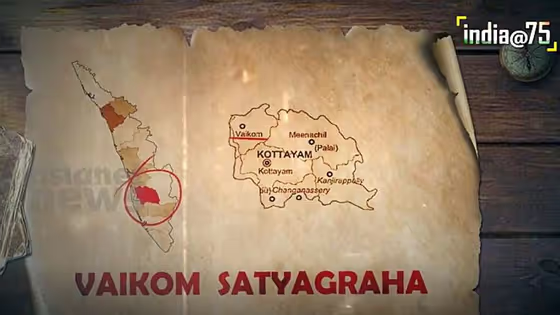
India@75: Vaikom Satyagraha, India's first movement against caste bias
The Vaikom Satyagraha was the first movement against caste discrimination waged by men and women of Hindu upper and lower castes and also other religions
Vaikom Satyagraha formed one of the most crucial chapters in India’s freedom movement. The first-ever agitation was led by Congress after it adopted the struggle against untouchability as a principal programme.

It was also the first movement against caste discrimination waged by men and women of Hindu upper and lower castes and also other religions. An unprecedented movement with the direct participation of Sree Narayana Guru, Mahatma Gandhi and E V Ramaswamy Naicker.
All roads were opened to the public without any discrimination in Tiruvithamkoor in 1865. Yet even six decades after this, the roads surrounding the Mahadevar Temple at Vaikom in Kottayam were barred to the people of lower castes.
Notice boards banning entry to lower castes guarded these roads. Even the sage Narayana Guru was once disallowed to travel through these roads.
An Ezhava young man resolved to fight against this discrimination. He was TK Madhavan. He was the editor of Desabhimani, Organising Secretary of Narayana Guru's Sree Narayana Dharma Paripalanayogam and also a Congress leader.
He went and met Gandhiji when he visited Tirunelveli and was appraised about the discrimination. Gandhiji promised him the support of Congress.
Accompanied by prominent writers and nationalists like Sardar KM Panikkar and KP Kesava Menon, Madhavan attended the Kakinada Session of Congress party in 1923 and succeeded in making the party adopt a resolution to struggle against untouchability.
Following this, the Kerala Pradesh Congress Committee under K Kelappan announced the Satyagraha at Vaikom. The Satyagraha with the participation of all castes was flagged off on 30 March 1924.
But the upper caste Hindu orthodoxy and the Tiruvithamkoor royal government were firmly opposed to any change in the tradition. Police proclaimed prohibitory orders around the Vaikom temple. But three young men of lower and upper castes violated the orders by walking through the forbidden streets and courted arrest.
Subsequently, scores of volunteers including leaders like Madhavan and Menon repeated the violation and continued to be rounded up and sent to prison. Conservatives and the police unleashed torture on the volunteers. But the non-violent struggle continued relentlessly braving even the great floods of 1924.
The struggle caught national attention and support came from all over the country. Sree Narayana Guru personally arrived at Vaikom and encouraged the agitators.
Gandhi arrived along with Rajagopalachari at Vaikom in March 1925. He held discussions with the Brahmin leader of the conservatives at Vaikom. The arrogant Brahmin leader even refused to permit Gandhi into his house in the name of untouchability. Gandhi also discussed with the Queen of Tiruvithamkoor and also met Narayana Guru. Following this, the arrested volunteers were released by the queen.
The satyagraha was withdrawn in November 1925. All four roads except one around the temple were opened to all. In 1936 the Tiruvithamkoor royal government made the Temple Entry Proclamation allowing entry for all Hindus to all the temples.